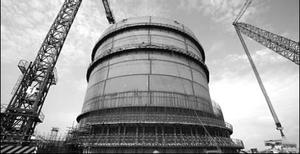Nuclear mattersControversial nuclear reactor design moving toward approval
A controversial new nuclear reactor design is moving ahead for approval by the U.S. Nuclear Regulatory Commission (NRC); the chairman of the NRC announced that the agency would open the design for public comment before deciding whether to approve the reactor; critics of the proposed reactor, a Westinghouse AP1000, believe that in the event of an accident its safety measures are inadequate; if approved, the reactor could be used in as many as fourteen nuclear power plants

Construction of one China's four AP1000 reactors // Source: chinadaily.com.cn
The chairman of the U.S. Nuclear Regulatory Commission (NRC)is pushing ahead for approval for a controversial Westinghouse designed nuclear reactor.
Last Wednesday, NRC Chairman Gregory Jaczko announced that the agency will open the proposed reactor design for public comment for seventy-five days before the commission decides whether to approve the reactor or not. The reactor, a Westinghouse AP1000, is the top choice of several utility companies seeking to build or expand nuclear power plants.
In Georgia, an $8.3 billion loan guarantee from the Department of Energy (DOE) has already been awarded to Southern Co which plans to use two AP1000s for a site.
The two utility companies are currently awaiting approval of their reactor plans and licenses from the NRC, which has stated that it will make a decision by the end of 2011.
According to Jaczko, “We will continue to work on a schedule that puts us in a position to make some final decisions possibly by the end of this year.”
Critics of the design worry that in the event of an accident the reactors containment features are inadequate.
Current reactors function like a thermos bottle in which a reactor is housed within concrete walls several thick feet that are lined with steel. In the event of an accident, emergency systems would kick in and pump water and other coolants in to prevent a meltdown.
The AP1000 is designed to minimize the use of pumps, valves, and human operators, instead relying on natural factors like gravity and heat dissipation to cool the reactor in an emergency. The AP1000 reactor is surrounded by a free-standing steel shell that is housed in a concrete building with an air gap between them.
If an accident were to occur, the steel shell would conduct heat to the air gap, where a naturally created chimney effect would whisk the heat away. A large water tank on the roof of the building would provide additional cooling by using gravity to carry water to the reactor instead of pumps.
The NRC has asked for some design changes to ensure that the water tank’s valves could be blown open in the event of an accident.
Arnie Gunderson, a nuclear engineer who recently testified before the NRC’s Advisory Committee on Reactor Safeguards on the AP1000’s design shortcomings, believes, however, that these measures are inadequate and do not address safety concerns.
“There’s no discussion of our concerns,” he says. “Perhaps they’ve just discounted it and decided not to memorialize it in writing.”
If approved, the reactor could be used in as many as fourteen nuclear power plants.
